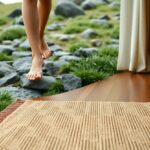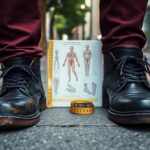Your cart is currently empty!
Category: Sports Recovery
-

Acupuncture and Cupping for Optimal Sports Recovery
Enhance Your Sports Recovery Journey with Acupuncture and Cupping Therapy
Your unwavering commitment to intense training demands an equally robust focus on recovery. This is where sports acupuncture and cupping therapy emerge as vital components of a comprehensive recovery strategy, effectively supporting your coaching and training efforts.
At JG Alternative Healthcare in Melbourne, we specialize in utilizing acupuncture, Electro Acupuncture, and cupping therapy to assist you in alleviating pain, easing muscle tension, and enhancing blood circulation for optimal athletic performance.
As you engage in various sports such as running, weightlifting, or team sports, you may ponder essential questions regarding your training and recovery.
How can I maintain consistent training without triggering flare-ups?
What methods can I use to improve my sleep quality and feel revitalized on game day?
What strategies are effective in reducing my recovery time post-training?In our clinic, we have consistently observed that precise needling and cupping techniques can significantly alleviate soreness in tissues, restore balance to the nervous system, and facilitate your body’s natural healing processes. Alongside effective load management, these methods ensure steady progress on your athletic journey.
The Importance of Acupuncture and Cupping for Your Athletic Recovery
While many athletes prioritize their training programs, nutrition, and strength workouts, the real potential for enhancing performance often lies in adopting effective recovery techniques. The body does not strengthen during training; rather, it adapts and grows during recovery periods. Acupuncture can effectively modulate pain signals, boost local blood flow, and mitigate stress responses, leading to a significant reduction in soreness and an improvement in flexibility and range of motion.
Cupping therapy utilizes a negative pressure mechanism on the skin and fascia, enabling tight layers to elevate and decompress. Many clients describe this sensation as a profound and relieving stretch. Research has shown that acupuncture can effectively lower pain intensity and improve functional capabilities for individuals experiencing musculoskeletal challenges. Additionally, cupping therapy is recognized for providing short-term relief from neck, shoulder, and back pain in adults. This compelling evidence underscores its value in a holistic recovery approach.
At JG Alternative Healthcare, we administer these therapies in a licensed clinical environment, guaranteeing that you receive safe, evidence-based procedures along with comprehensive follow-up care. Our emphasis is on active individuals who seek practical and effective solutions that seamlessly integrate into their training routines.
Accelerate Your Recovery with Targeted Sports Acupuncture Techniques
Sports acupuncture specifically targets acupuncture points tailored to the unique demands of your athletic pursuits.
For example, a runner dealing with calf tightness or plantar foot pain may find relief through localized acupuncture points in the calf area, along with distal points near the hand or forearm to enhance pain modulation. In certain situations, we may employ Electro Acupuncture to activate a trigger point and restore muscle function.
Conversely, for a weightlifter suffering from shoulder discomfort, our focus may shift to the rotator cuff, neck, and thoracic spine to improve scapular mobility. In Traditional Chinese Medicine (TCM), the extremely fine needles used often create a dull, heavy sensation known as de qi. Many athletes appreciate this feeling as it signifies that we are effectively stimulating the target area.The goals of our therapy sessions are threefold.
Firstly, we aim to rapidly alleviate pain to enhance your movement quality. Secondly, we prioritize improving local circulation to ensure that tissues receive the essential nutrients required for optimal healing. Lastly, we work to calm the nervous system, fostering better sleep and establishing a more predictable recovery process.
Randomized studies indicate considerable improvements in pain relief and functional capacity for conditions like knee osteoarthritis and tendinopathy. While no single method is universally effective, the evidence supports the incorporation of acupuncture within a well-rounded recovery strategy that also encompasses strength training, mobility exercises, and practical load management. We collaborate closely with your physiotherapist or coach to ensure our sessions align perfectly with your specific training phases.
Experience the Benefits of Cupping Therapy for Pain Relief and Enhanced Mobility
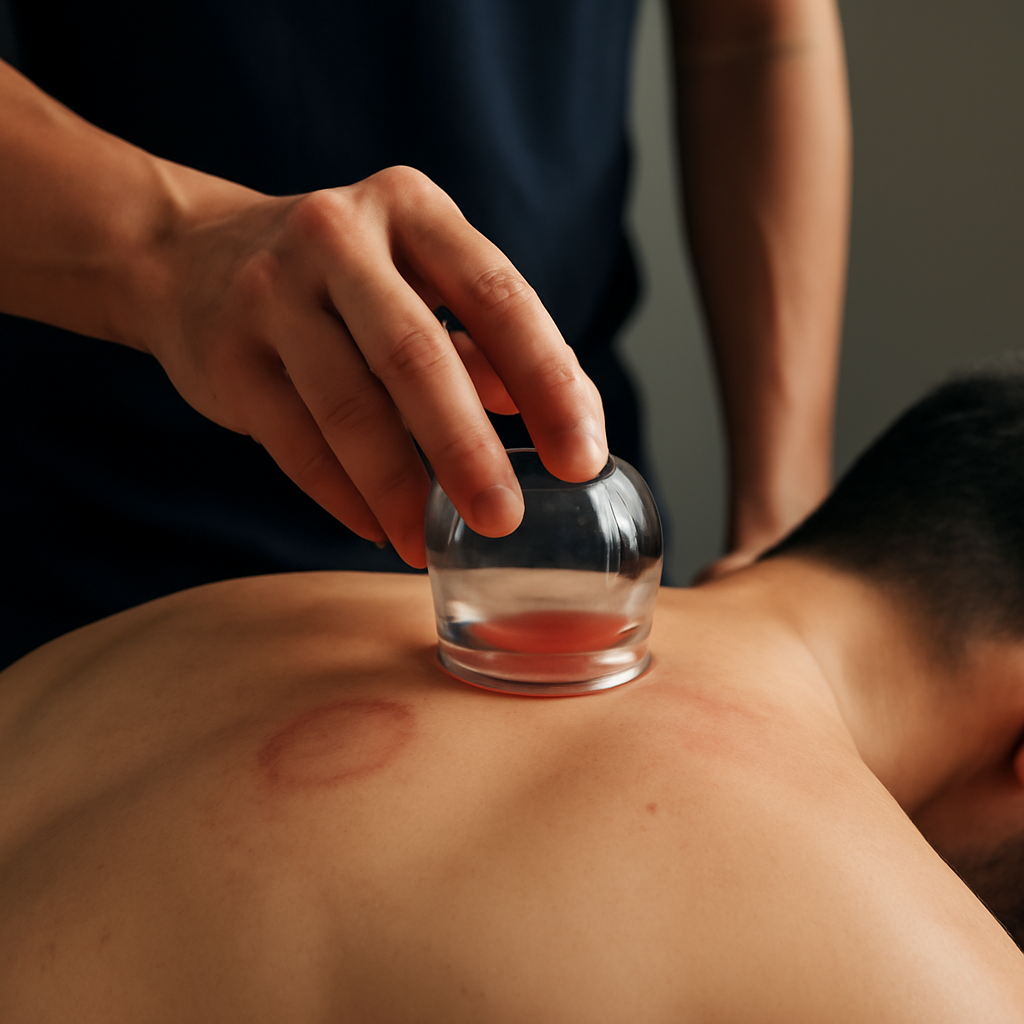
Numerous athletes report that cupping therapy offers a unique form of release compared to traditional manual pressure, as it lifts rather than compresses soft tissues. Within Traditional Chinese Medicine (TCM), cupping is believed to mobilize stagnation and promote the flow of both energy and blood. In the context of sports, this effectively alleviates myofascial stiffness, enhances circulation, and allows joints to move freely without the hindrance of tight fascia.
It is common to observe circular marks that gradually diminish over several days following cupping sessions. These marks are not bruises caused by blunt force; instead, they signify areas where the cup has drawn fluid toward the surface of the skin while decompressing the deeper layers of tissue.
We often combine cupping with Gua Sha Therapy, which employs a smooth tool to glide along tense muscle lines, coupled with gentle active movements to help sustain the benefits gained from the therapy.
Scientific evidence supports the efficacy of cupping therapy for providing short-term pain relief in areas such as the neck, shoulders, and back. Athletes frequently report feelings of lighter legs and increased freedom of movement in their backs following treatment. Moreover, proper hydration, adequate protein intake, and quality sleep can contribute to maintaining these improvements between therapy sessions.
Your Experience at JG Alternative Healthcare: What to Expect During Your Visit
Effective healthcare is built on clarity, consistency, and collaboration. During your initial appointment, we will conduct a brief movement assessment, discuss your training regimen, and develop a customized plan that aligns with your schedule and goals. We will set clear and achievable objectives, such as walking without pain, enjoying restful sleep, or returning to tempo runs within a specific timeframe. We take the time to explain each step of the process and encourage you to ask questions, as we believe confidence stems from understanding what to expect and why it is crucial for your athletic performance.
- Assessment: Includes a movement screen, palpation, and the establishment of clear goals
- Treatment: Options encompass acupuncture, Electro Acupuncture, cupping, Gua Sha Therapy, and targeted manual therapy
- Support: We may provide breathable tape, home exercises, and practical recovery habits as needed
- Follow-up: We will review your progress, adjust treatment loads, and modify therapy as necessary
If you have any inquiries regarding your situation, please do not hesitate to reach out or schedule an appointment through our website. We proudly serve athletes and active individuals from Moonee Ponds, South Morang, and surrounding suburbs, and we collaborate seamlessly with your healthcare team whenever beneficial.
When to Utilize Each Recovery Method: A Handy Reference Guide
Recovery Method Ideal For Expected Sensations Session Focus Typical Additions Acupuncture Tendinopathy, muscle strains, lower back pain, migraines, stress management Dull ache or heaviness at needle sites, easing within moments Pain modulation, improved circulation, balancing the nervous system Commonly paired with gentle mobility exercises Electro Acupuncture Chronic trigger points, nerve-related pain, persistent shoulder or knee issues Soft pulsing sensation, adjustable intensity based on comfort Motor unit resetting, reduced muscle guarding, improved control Applied for 10 to 20 minutes during a standard treatment Cupping Therapy Myofascial tightness, delayed onset muscle soreness (DOMS), tension from static posture Strong stretching sensation or suction, followed by a feeling of lightness Decompression, facilitating glide, and enhancing tissue mobility Static and moving cups, with marks fading over days Gua Sha Therapy Neck and back tightness, overuse injuries in calves or forearms Scraping sensation accompanied by warmth, quick relief Fascial release, boosting local circulation Short, focused applications prior to movement Proven Strategies to Optimize Your Recovery Results
You can amplify the benefits of your treatments through simple yet impactful habits. These practices honor your body’s innate recovery capabilities while recognizing how stress can influence pain levels. They also ensure your recovery plan remains practical, as consistency holds greater value than striving for perfection. Begin by selecting one or two habits to implement, and gradually introduce more as your schedule permits. Small, incremental enhancements can lead to significant progress over the course of a long athletic season.
- Ensure adequate hydration to support tissue health and boost circulation, particularly after cupping sessions
- Prioritize restful sleep, as it plays a crucial role in recovery and maintaining a balanced nervous system
- Integrate gentle movement breaks on rest days to preserve your range of motion
- Practice slow, deep breathing for two minutes to alleviate stress and reduce muscle tension
- Warm up gradually using gentle movements instead of intense jumps, and adjust your load based on your daily energy levels
- Maintain consistent protein intake along with a variety of colorful fruits and vegetables to facilitate tissue repair and support digestion
- Keep a log of your pain levels and energy fluctuations with brief notes to guide informed adjustments to your routine
Why JG Alternative Healthcare Is Your Top Choice for Recovery Solutions in Melbourne
JG Alternative Healthcare is a licensed acupuncture and Chinese Medicine clinic led by Jesse Georgiadis, an experienced practitioner in sports medicine. We bridge the divide between conventional treatments that often only address symptoms and unregulated services that may lack essential safety protocols. Our evidence-informed approach respects your sport, your time, and your individual aspirations. Our treatments aim to enhance circulation, alleviate tension, regulate bodily systems, and support your body’s natural recovery processes without making unfounded claims of cure.
We prioritize transparency in our treatment plans, continuous progress monitoring, and maintaining open lines of communication.Your Next Steps: If you have questions about how these methods can specifically benefit your sport, please reach out to us, and we will provide tailored options that align with your training schedule and objectives.
Consider the transformative changes that could take place in your athletic performance if you achieved a harmonious balance in your recovery each week, and how might sports acupuncture facilitate that important transition?
Transform Your Recovery Experience with Sports Acupuncture at JG Alternative Healthcare
Athletes and active individuals can experience improved recovery, greater mobility, and enhanced focus through Sports Acupuncture at JG Alternative Healthcare.
Book Your Appointment Today
The Article: Acupuncture and Cupping for Sports Recovery Treatments first appeared on https://writebuff.com
The Article Acupuncture and Cupping: Effective Sports Recovery Solutions Was Found On https://limitsofstrategy.com
-
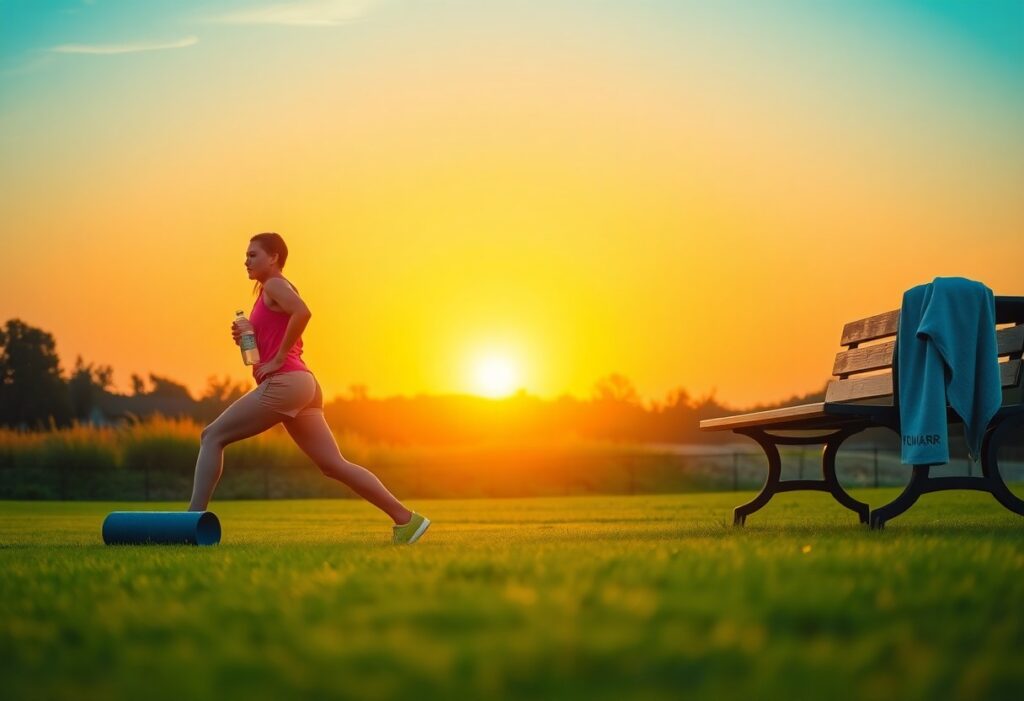
Running Recovery Tips: 8 Key Essentials for Better Performance

As you work hard to expand your capabilities in running—whether it’s enhancing your distance or improving your pace—it is crucial to place a strong emphasis on your recovery process. Ignoring recovery can lead to injuries and debilitating fatigue, which can seriously impede your progress. By integrating essential recovery strategies into your routine, including effective cool-downs, comprehensive stretching, and consistent hydration practices, you can significantly improve your overall performance and endurance. Taking the necessary time to nurture your body post-run not only lessens muscle soreness but also enriches your overall running experience, ultimately transforming you into a stronger and more efficient runner.
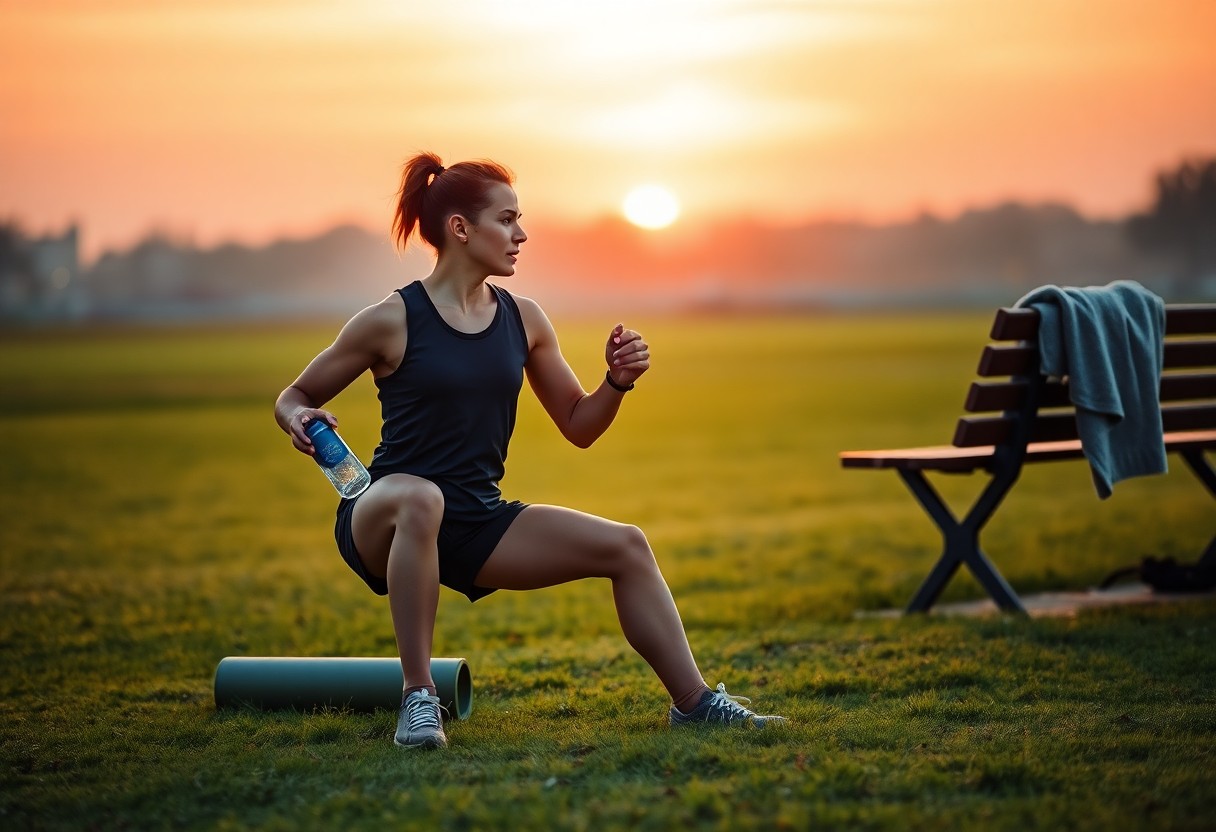
Explore the Essential Types of Recovery Techniques for Runners
Recovery can be classified into various types, each playing a significant role in your comprehensive training program. You can break down recovery into physical and nutritional categories, which are both vital for an effective recovery strategy. The primary types of recovery that you should take into account include:
- Physical Recovery: This involves techniques such as foam rolling, effective stretching exercises, and ensuring you get adequate sleep.
- Nutritional Recovery: This focuses on the importance of hydration, replenishing your energy stores, and consuming anti-inflammatory foods to support your recovery.
By developing a clear understanding of these recovery types, you can tailor a recovery plan that aligns perfectly with your specific running objectives and personal needs.
Recovery Type Description Physical Recovery Involves physical methods for recovery, including foam rolling and stretching exercises designed to enhance flexibility. Nutritional Recovery Focuses on dietary strategies for recovery, highlighting the critical roles of hydration and replenishment of energy. Sleep Essential for recovery, aiming for 7-9 hours of quality sleep every night to promote healing. Hydration Stresses the importance of adequate water intake, targeting at least 400 ml per hour during your runs to maintain performance. Active Recovery Involves engaging in light cardio activities, such as walking or yoga, to facilitate recovery and enhance well-being. Key Physical Recovery Techniques to Restore Your Muscles
Prioritizing physical recovery techniques, including foam rolling and stretching, is fundamental for helping your muscles recover effectively after a run. These practices not only enhance your flexibility but also assist in preventing muscle soreness, which can impede your performance in subsequent workouts. Establishing a consistent routine that incorporates these recovery techniques will greatly improve your overall running experience and help keep you free from injuries.
Nutrition: Strategies for Optimal Recovery After Running
Certain foods are particularly advantageous for nutritional recovery, especially those abundant in carbohydrates and protein, which are crucial for replenishing energy stores and repairing muscle tissue after your exertion. Additionally, incorporating anti-inflammatory foods such as tomatoes, spinach, and berries into your meals can significantly diminish muscle inflammation, thereby promoting a more efficient recovery process.
Your nutritional recovery strategy is vital for runners, as it directly influences energy replenishment and muscle repair. Consuming a balanced meal or snack that includes carbohydrates and protein soon after your run can expedite your recovery. Staying hydrated is equally crucial—ensure you are consuming enough water and integrating anti-inflammatory foods into your diet to mitigate muscle soreness. After completing a run, prioritize eating a well-rounded meal that combines carbohydrates, protein, and healthy fats to effectively support your body’s recovery needs.
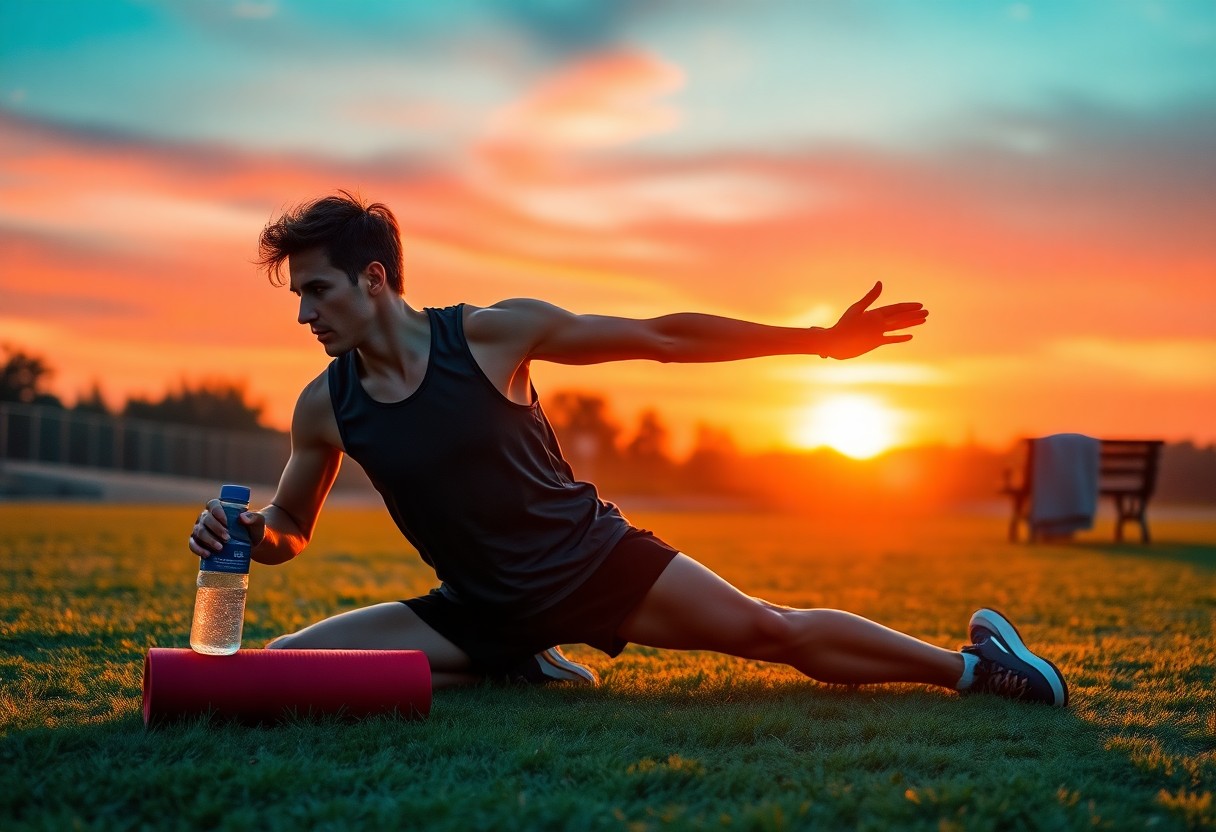
Effective Strategies to Enhance Your Recovery After Running
To elevate your running performance and enhance your recovery, consider incorporating these effective strategies into your routine:
- Maintain optimal hydration throughout your run to support bodily functions.
- Engage in a comprehensive post-run cool-down routine to help your body transition.
- Incorporate stretching into your recovery regimen to improve flexibility and reduce tension.
Understanding the unique recovery needs of your body and integrating these essential tips into your routine can lead to improved endurance and overall performance as a runner.
The Vital Role of a Cool Down and Stretching in Recovery
If you’re aiming to reduce soreness and boost recovery after a run, consider incorporating a slow jog or walk as part of your cool-down routine. Following this, dedicate time to stretching the major muscle groups used during your run to facilitate greater recovery and enhance flexibility.
Hydration and Nutrition: The Cornerstones of Peak Performance
As a guideline, aim to consume at least 400 ml of water per hour while running, and be sure to drink 16-24 fluid ounces for every pound lost during your run. This method will help you maintain proper hydration levels and effectively bolster your recovery.
To optimize your hydration and nutrition strategies, monitor your urine color as a gauge for hydration status, and consume a meal or snack rich in carbohydrates and protein shortly after your run to support muscle repair and recovery. Ensuring adequate hydration and proper nutrition can significantly reduce the risk of injury and overtraining, enabling you to perform at your peak and achieve your running goals.
A Detailed Step-by-Step Guide to Optimize Your Recovery
Recovery encompasses multiple factors that are essential for optimizing your training. The following table summarizes the critical components of recovery:
Recovery Aspect Importance Level Proper cool-down High Stretching and foam rolling High Hydration and nutrition Critical Active recovery days Important The Significant Benefits of Foam Rolling and Self-Massage Techniques
Simple yet effective practices like foam rolling can greatly assist in reducing muscle soreness and enhancing recovery. By regularly incorporating foam rolling into your routine, you can improve your overall performance while simultaneously decreasing the risk of injuries.
Boosting Recovery Through Active Recovery Days and Light Cardio
Including light cardio on your recovery days is an excellent way to enhance blood circulation and support muscle flexibility. Activities such as walking, jogging, yoga, or swimming can effectively facilitate proper recovery without imposing excessive stress on your body.
Approach your recovery with a balanced mindset. During active recovery days, remember that consistency is vital. By consistently integrating these activities into your routine, you will enhance your endurance and boost your performance. Always listen to your body and adjust your routine as necessary, since overexertion can lead to injuries. With a well-structured recovery plan, you can effectively achieve your running goals while maintaining a healthy and active lifestyle.
Key Factors Influencing Your Recovery Process
Every runner recognizes that effective recovery is crucial for improving performance and endurance. Several significant factors that affect your recovery include:
- Diet and its nutritional quality
- Sleep and how restful it is
- Strength training as part of your overall routine
- Cardio frequency and intensity
The effectiveness of your recovery regimen can have a profound impact on your success as a runner.
The Crucial Role of Sleep and Rest in Recovery
Recognizing the significance of recovery is essential, particularly in relation to sleep and rest. Aim to achieve 7-9 hours of quality sleep each night, allowing your body to rejuvenate and recover from demanding training sessions.
Selecting Appropriate Footwear for Enhanced Comfort and Recovery
If your goal is to recover more effectively, pay close attention to your footwear choices during rest periods. Investing in recovery shoes and comfortable sandals can provide invaluable relief after long runs, making them a wise choice for dedicated and long-distance runners.
By choosing the right footwear, you can significantly reduce post-exercise discomfort in your legs and feet following challenging runs or workouts. For instance, Xero Shoes feature a thin, flexible sole that allows you to receive ground feedback, engaging your feet during movement. This approach can hasten your recovery and improve your overall performance. The comfort and support provided by quality recovery shoes can greatly influence your recovery journey, enabling you to return to training sooner and perform at your best.

The Vital Importance of Nutrition in the Recovery Process
Your diet plays an integral role in your recovery process after a run. It’s essential to provide your body with the appropriate nutrients to facilitate muscle repair and replenish energy expended during your run.
Optimal Foods to Support Muscle Repair and Growth
To effectively promote muscle repair and growth, concentrate on consuming meals or snacks high in carbohydrates to restore glycogen levels and protein to assist in muscle rebuilding. It is advisable to eat a balanced meal or snack promptly after completing your post-run cool-down and stretching routine for the best recovery results.
Including Anti-Inflammatory Foods for Improved Recovery
As you prioritize your recovery, be sure to incorporate anti-inflammatory foods such as tomatoes, spinach, kale, collards, almonds, walnuts, salmon, strawberries, and blueberries into your diet. These foods are beneficial in alleviating muscle soreness and inflammation, promoting a swifter recovery.
Anti-inflammatory foods also serve a critical role in accelerating your recovery. By minimizing inflammation and muscle damage, you can return to your training regimen more quickly and perform at your peak. Strive to integrate these foods into your meals and snacks, particularly after long or intense runs, to assist your body in adapting to the demands of running. Doing so will help lower your chances of overtraining and injuries, allowing you to effectively pursue your running aspirations.
Analyzing the Advantages and Drawbacks of Different Recovery Techniques
With a multitude of recovery methods available, it is essential to assess the pros and cons associated with each approach.
Recovery Method Pros and Cons Rest Helps to mitigate the risk of injury and enhances mental health, but may result in decreased performance levels. Active Recovery Boosts blood circulation and alleviates muscle soreness, but might increase the risk of overtraining. Foam Rolling Reduces muscle soreness and encourages recovery but can be time-consuming. Choosing a recovery method that aligns with your personal needs is essential. It’s vital not to overlook recovery, as neglecting it can lead to serious injuries and reduced performance.
The Advantages of Active Recovery Techniques
Conversely, participating in active recovery can yield substantial benefits, as it fosters enhanced blood flow and eases muscle soreness, allowing you to recover more quickly and perform better in your next running session.
Recognizing the Risks of Overtraining and Ignoring Recovery
Overtraining and neglecting recovery can result in serious injuries, including stress fractures, as well as decreased performance. This highlights the importance of prioritizing recovery and listening to your body throughout your training journey.
Failing to prioritize recovery can lead to serious consequences, such as chronic fatigue, diminishing motivation, and an increased likelihood of injury. It is essential to make recovery a priority in your training regimen, which may encompass logistical solutions like car rentals for convenient transportation to recovery sessions, or considering a rental car for a stress-free recovery getaway.
Emphasizing the Importance of Recovery in Your Running Journey
Remember, by integrating these eight essential recovery tips into your routine, you can profoundly enhance your running performance and endurance. Prioritizing recovery not only aids in reducing muscle soreness but also facilitates a quicker return to your running regimen. By adopting these strategies, you are setting yourself on the path to achieving your running objectives and evolving into a more proficient runner.
Common Questions About Recovery for Runners
Q: Why is recovery so vital for runners?
A: Recovery is essential for runners because it allows the body to rest, rejuvenate, and restore itself after a run. This process helps prevent muscle damage, overtraining, and injuries. Effective recovery enables the body to adapt to training, fostering strength, speed, and resilience against injury.
Q: What are some effective strategies for recovery after running?
A: Effective post-run recovery strategies include cooling down, stretching, using a foam roller, hydrating, replenishing lost fluids, engaging in light cardio on recovery days, consuming suitable foods, ensuring adequate sleep, and wearing recovery footwear. These methods help alleviate muscle soreness, boost performance, and accelerate recovery.
Q: How can I effectively prioritize my recovery routine to improve my running performance?
A: To prioritize your recovery routine, set aside time for a thorough cool-down and stretching after each run. Include foam rolling, light cardio, and strength training into your weekly schedule. Focus on a balanced diet rich in carbohydrates and protein, and strive for 7-9 hours of restful sleep each night. By emphasizing recovery, you will enhance your running performance, improve endurance, and decrease the risk of injuries.
The Article 8 Essential Running Recovery Tips to Boost Your Performance and Endurance appeared first on My Shoes Finder

